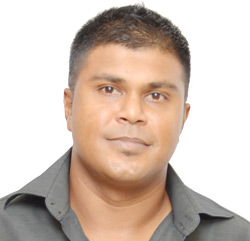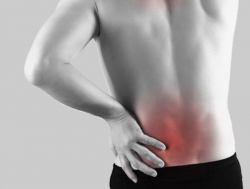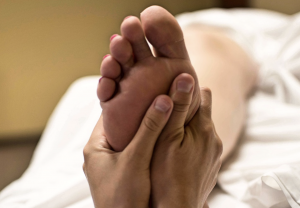“It’s about love… if you don’t love what you do, your energy could never be transferred to heal someone else’s pain.” – Amir Ali
Amir Ali knew he had found his calling when a chance encounter opened the world of massage to him.
“Doing martial arts from a young age, I had many injuries and healed myself through research and experimenting,” explains Amir. “Then, while I was working for a short time on the set of the local film The Pan Man, I tried massages on myself and on others, and it seemed to work… and someone mentioned that there was a local massage college.”

Eager to learn, he sought out the recently established Trinidad and Tobago College of Therapeutic Massage and Beauty Culture, but it was too late — the programme had already started three months earlier.
I’m not leaving this compound till you put me in this programme“I sat by the door with my cash in hand and said, ‘I will make up the work. I’m not leaving this compound till you put me in this programme,’ ” reminisces Amir.
Amir graduated top of his class and was one of the first graduates of the College in 1997. A licensed deep tissue medical massage therapist and sports massage therapist, he is now the President of the Massage Therapy Association of Trinidad and Tobago.
The Massage Association, which officiates the licensure exam (previously handled by the College), is a voluntary association for the nation’s licensed massage therapists — some 300 qualified graduates to date. The Association handles matters including certification of newly licensed practitioners, seeking out new ventures and activities for the Association, and ongoing matters of concern for the practice of the therapy in the country.
One of these matters in the widely held viewpoint locally, that massage is not recognised as a medical profession — a perception Amir is trying hard to change.
Benefits of Massage
Some of the key benefits of massage, in its broadest form, include:

- Reduction of muscular pain and stiffness, and repair of muscle fibres
- Stimulation of circulation, which helps the skin to receive fresh oxygen and nutrients, and also improves the skin colour and muscle tone
- Release of tension and relief of mental and physical pain including chronic conditions such as headaches, neck and back pain and arthritis
- Acceleration of the lymphatic system, which helps to cure infections and get rid of toxins
- Relief of anxiety and depression, which promotes good health and general well-being
One of Amir’s specialities, deep tissue massage, helps to break up scar tissue after surgeries, which enables the physical therapist to then work with the patient much more effectively.
His other speciality, sports massage, is crucial for athletes at all stages — preparation before the event, during the event to calm the athlete in between races or games, and after the event to detox the athlete and get rid of lactic acid.
Often there is some crossover between the two specialities and between many other forms of massage as well.
But beyond the various types of massage and their respective benefits, Amir believes the most important in any kind of massage is the simplicity of touch.
Healing with Touch
“Touch is therapeutic,” Amir says. “As a child, we grow with touch. We love touch but many people don’t like to admit it.”
We love touch but many people don’t like to admit itHe adds: “As adults, we don’t go out and cry in public… but when you’re dealing with someone in pain, they lie on your bed, their emotions are open and raw in the room with you, and they tell you anything.”

With the assistance of Pearl Gopaul, who introduced the College to Trinidad, Amir learnt how to work with energy and manage the strength of his hands, so that negative energy would not be transferred onto him.
Amir’s keenness to learn and practice what he learnt has always been his nature.
As a young massage therapist, he went to public parks and took notes on the people he observed around him, and later approached them to see if his guesses about their pain were accurate.
“The first four years of my career I did for free,” he says. “I worked odd jobs mixing concrete and doing yard work — just to get a little travel money so I could go and do my free massages.
“But what I learnt in those four years — no one can take that from me.”
Even now, with 17 years of experience under his belt, he still donates his services for good causes, for instance to orphanages or for charity events.
Four Julie mangoes. That was my best payment“Once, after I massaged an elderly lady, she asked my price and I called $150 which is far below my usual price,” he reminisces.
“She began to pull out singles and fives to make up the money, and I told her ‘No charge’. She went in the back and brought out four Julie mangoes. That was my best payment.”
The Consummate Professional
Dealing in the therapy of touch, Amir is always very careful to respect others.
When it comes to touch, there is always a fine line, particularly in the Caribbean where body consciousness is deeply engrained in our culture.
Do I have to take my clothes off?The fear that prevents many people from ever going to get a massage, is palpable in the question: ‘Do I have to take my clothes off?’, which is a religious and cultural concern for some, particularly Muslims.
Amir also notes that the greater percentage of his clientele is female, but this can perhaps be attributed to an aversion about touching that many men may have — both about another man touching them, and about being touched in general.
“It is a touchy profession — literally,” he explains wryly. “It only takes one person to say ‘This man touched me inappropriately’, and that will be it.”
To overcome these challenges of the profession, he ensures that the patient is covered everywhere except where he or she needs to be touched, and also explains each action during a massage to help the patient to be at ease. He also welcomes the patient’s family and friends into the massage room, particularly if he has a young patient under 16.
“We are not masseuses, we are licensed massage therapists,” he reiterates. “If my mother or my wife lies down on my table, they are my patients. I love what I do, and that is the key to life on the whole: discipline, professionalism, and love.”
Further Information
- If you have a specific pain, it’s best to go to a doctor first. After an MRI, CT scan, or X-ray, the doctor would then evaluate the best approach to relieve the pain, and refer the patient to a massage therapist if needed. Sometimes, a physical trainer is needed rather than a massage therapist, for instance if there is a trigger point pain.

